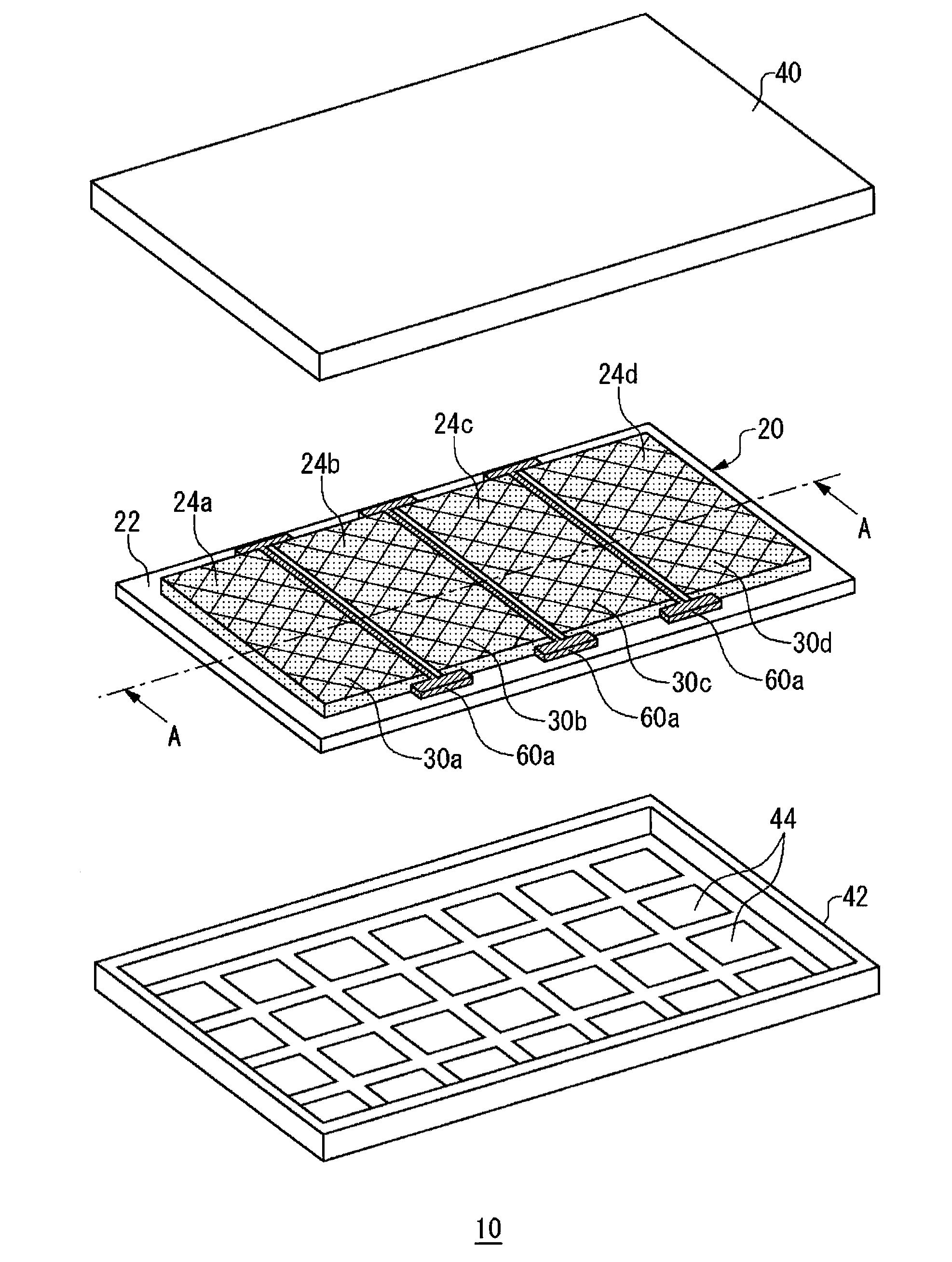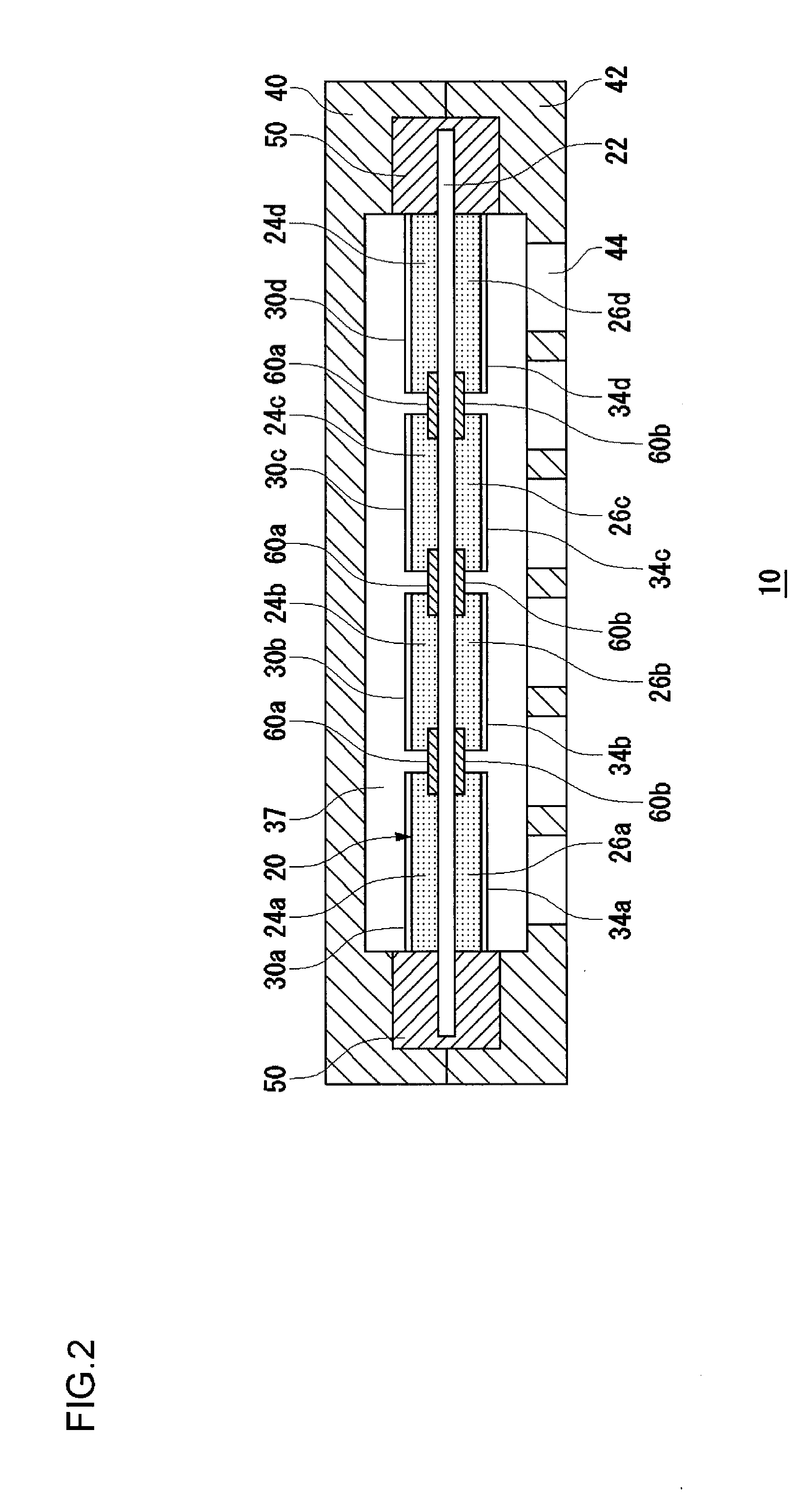Membrane electrode assembly and fuel cell
a membrane electrode and fuel cell technology, applied in the field of fuel cells, can solve the problems of short circuit, electrolyte membrane deterioration, hydrogen leakage, etc., and achieve the effect of narrowing the interval (spacing), preventing short circuit, and narrowing the interval
- Summary
- Abstract
- Description
- Claims
- Application Information
AI Technical Summary
Benefits of technology
Problems solved by technology
Method used
Image
Examples
first embodiment
[0032]FIG. 1 is an exploded perspective view showing a structure of a fuel cell according to a first embodiment of the present invention. FIG. 2 is a cross-sectional view taken along the line A-A of FIG. 1. As shown in FIG. 1 and FIG. 2, a fuel cell 10 includes a membrane electrode assembly (MEA, also called a catalyst-coated membrane (CCM)) 20, an anode housing 40, and a cathode housing 42. A sealing member 50 (described later) is provided around the peripheral edge part of the membrane electrode assembly 20.
[0033]The membrane electrode assembly 20 includes an electrolyte membrane 22, anode catalyst layers 24a to 24d, and cathode catalyst layers 26a to 26d, which are disposed counter to the anodes 24a to 24d, respectively. Hereinafter, the anode catalyst layers 24a to 24d may be collectively called “anode catalyst layer 24” also, and the cathode catalyst layers 26a to 26d may be collectively called “cathode catalyst layer 26” also. Hydrogen is supplied to the anode catalyst layers ...
example 1
[0070]In Example 1, Nafion membrane is used as the electrolyte membrane. The Nafion membrane is formed on the electrolyte membrane as an insulating layer. The catalyst slurry by using Nafion as an ionomer is applied to both faces of the electrolyte membrane so as to prepare a membrane electrode assembly of Example 1. That is, in the membrane electrode assembly according to the first embodiment, the same material is used for both the electrolyte membrane and the insulating layer. Then the laser processing is performed on only one surface of the membrane electrode assembly by using excimer laser.
example 2
[0074]In Example 2, Nafion membrane is used as the electrolyte membrane. The Nafion membrane is formed on the electrolyte membrane as an insulating layer. Then the catalyst slurry using sulfonated polystyrene-block-poly(ethylene-ran-butylene)-block-polystyrene as an ionomer is applied to both faces of the electrolyte membrane so as to prepare a membrane electrode assembly of Example 2. The laser processing is performed on only one surface of the membrane electrode assembly by using excimer laser.
Experimental Result 2
[0075]An observation of Comparative Example 1, which is a photograph of a membrane electrode assembly, after subjected to laser irradiation, according to Comparative Example 1 is shown in FIG. 5. Bubble-like matters occur in regions which are irradiated with laser. This verifies that the electrolyte membrane is damaged by laser irradiation.
[0076]An observation of Example 1, which is a photograph of a membrane electrode assembly, after subjected to laser irradiation, acco...
PUM
| Property | Measurement | Unit |
|---|---|---|
| width | aaaaa | aaaaa |
| thickness | aaaaa | aaaaa |
| width | aaaaa | aaaaa |
Abstract
Description
Claims
Application Information
 Login to View More
Login to View More - R&D
- Intellectual Property
- Life Sciences
- Materials
- Tech Scout
- Unparalleled Data Quality
- Higher Quality Content
- 60% Fewer Hallucinations
Browse by: Latest US Patents, China's latest patents, Technical Efficacy Thesaurus, Application Domain, Technology Topic, Popular Technical Reports.
© 2025 PatSnap. All rights reserved.Legal|Privacy policy|Modern Slavery Act Transparency Statement|Sitemap|About US| Contact US: help@patsnap.com



